Looking to reduce your environmental impact and create a more sustainable home? This article will show you how to make your house more eco-friendly. Discover energy-efficient lighting options, water conservation strategies, and sustainable materials for construction. Learn how to implement a recycling system, reduce energy consumption in appliances, and create a composting system. Explore the benefits of installing solar panels or other renewable energy sources. Improve indoor air quality through natural ventilation. Get ready to transform your home into an environmentally friendly haven!
Energy-Efficient Lighting Options

LED lights are a great option for energy-efficient lighting in your home. LED bulbs use significantly less energy compared to traditional incandescent bulbs, making them an excellent choice for eco-friendly lighting solutions. These bulbs are designed to emit light in a specific direction, ensuring that the majority of the generated light is used effectively. Unlike incandescent bulbs, which waste a lot of energy as heat, LED lights remain cool to the touch and convert almost all their energy into light.
In addition to being energy-efficient, LED bulbs also have a longer lifespan than traditional bulbs. On average, LED lights can last up to 25 times longer than incandescent bulbs. This means fewer replacements and less waste over time.
Furthermore, you can enhance the benefits of LED lighting by incorporating smart lighting technology into your home. Smart lighting systems allow you to control your lights remotely through smartphone apps or voice commands. You can adjust brightness levels, set timers or schedules, and even change colors with some models. By using smart technology, you can further optimize your energy usage and create personalized lighting settings tailored to your needs.
Overall, switching to LED bulbs and integrating smart lighting technology provides an effective way to reduce energy consumption in your home while enjoying long-lasting and customizable illumination.
Water Conservation Strategies
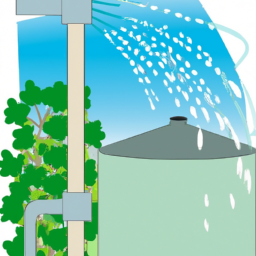
One way you can reduce water consumption is by installing low-flow faucets and showerheads. These fixtures are designed to limit the amount of water that flows through them without sacrificing performance. By replacing your old, inefficient faucets and showerheads with low-flow alternatives, you can significantly reduce your water usage.
Another effective strategy for conserving water is to implement rainwater harvesting techniques. This involves capturing rainwater from your roof or other surfaces and storing it for later use. You can install a rain barrel or a more complex rainwater harvesting system to collect and store this precious resource. The collected rainwater can then be used for tasks like watering your garden or washing your car, reducing the need for fresh water.
Additionally, choosing drought tolerant landscaping options can greatly reduce your outdoor water consumption. Planting native species that are adapted to your region’s climate can thrive with minimal irrigation. These plants have evolved to survive in arid conditions and require less water than non-native species. Incorporating mulch into your landscaping design can also help retain moisture in the soil, reducing the need for frequent watering.
Sustainable Materials for Construction
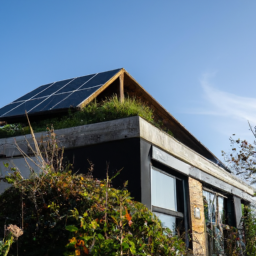
When choosing materials for construction, consider using sustainable options like bamboo or recycled steel to reduce your environmental impact. Not only will these materials help you create a more eco-friendly home, but they also offer numerous benefits in terms of durability and energy efficiency.
For green insulation options, consider using materials such as cellulose insulation or sheep’s wool. Cellulose insulation is made from recycled paper products and treated with fire-retardant chemicals. It provides excellent thermal performance and reduces the need for heating and cooling, ultimately lowering energy consumption. Sheep’s wool insulation is another great option that is renewable, biodegradable, and has natural insulating properties. It can effectively regulate temperature and moisture levels within your home.
When it comes to eco-friendly roofing materials, there are several choices available. One popular option is metal roofing made from recycled steel or aluminum. Metal roofs are durable, long-lasting, and can be fully recycled at the end of their lifespan. Another option is clay or concrete tiles which are made from natural materials that offer excellent durability and insulation properties.
Implementing a Recycling System
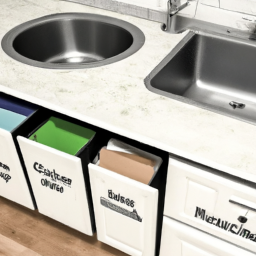
Implementing a recycling system in your home can help reduce waste and contribute to a more sustainable environment. Waste management is an essential aspect of living eco-friendly, and recycling plays a significant role in this process.
To start, set up separate bins for different types of recyclables such as paper, plastic, glass, and metal. Educate yourself about what can be recycled in your area and make sure to follow the guidelines. Rinse out containers before placing them in the recycling bin to avoid contamination.
In addition to recycling, consider using eco-friendly cleaning products to minimize harmful chemicals that can harm both your health and the environment. Look for products that are labeled as biodegradable or made from natural ingredients. These options are typically safer for you and the planet.
Furthermore, remember to reduce waste before it even becomes necessary to recycle. This means opting for reusable items instead of single-use ones whenever possible. For instance, bring your own shopping bags when grocery shopping or use refillable water bottles instead of buying plastic ones.
Reducing Energy Consumption in Appliances
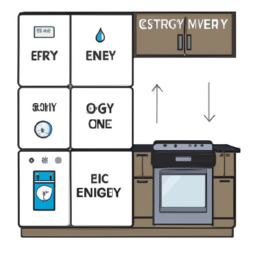
To reduce energy consumption in your appliances, start by unplugging them when they are not in use. This simple habit can save you a significant amount of energy and lower your electricity bills. However, there are also smart home technologies available that can help you monitor and manage your energy usage more efficiently.
Smart home technologies such as energy monitoring devices allow you to track how much energy each of your appliances is using. These devices provide real-time data on your energy usage, helping you identify which appliances are consuming the most power. With this information, you can make informed decisions to reduce your overall energy consumption.
In addition to monitoring devices, there are also smart plugs and power strips available that allow you to control the power supply to individual appliances remotely. By connecting these devices to your smartphone or voice assistant, you can easily turn off appliances even when you’re not at home.
Another option is to invest in Energy Star certified appliances that are designed for maximum efficiency. These appliances have been tested and proven to consume less energy without compromising performance.
Creating a Composting System
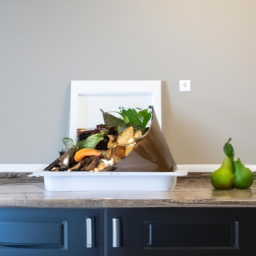
Creating a composting system is a great way to reduce food waste and nourish your garden with nutrient-rich soil. Composting offers multiple benefits for both the environment and your personal gardening endeavors. By diverting organic waste from landfills, you can significantly reduce methane emissions, a potent greenhouse gas that contributes to climate change. Additionally, composting allows you to create your own natural fertilizer, eliminating the need for chemical-based alternatives.
There are various methods you can use to start composting at home. One popular option is backyard composting, which involves creating a pile or using a bin in your yard. This method requires layering green materials (such as fruit and vegetable scraps) with brown materials (like leaves and twigs). Turning the pile regularly helps speed up the decomposition process.
If you have limited outdoor space or live in an urban area, vermicomposting might be more suitable for you. Vermicomposting utilizes worms to break down organic matter into nutrient-rich castings. All you need is a worm bin filled with bedding material like shredded newspaper and kitchen scraps.
Regardless of the method you choose, remember to monitor moisture levels and ensure proper airflow within your compost pile or bin. With time and patience, you will be rewarded with dark, crumbly compost that will enhance the health of your plants while reducing waste in an eco-friendly manner.
Installing Solar Panels or Other Renewable Energy Sources
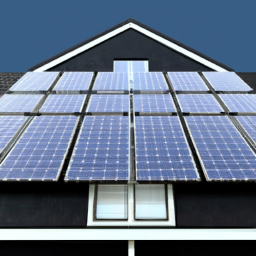
Installing solar panels or other renewable energy sources is a cost-effective and sustainable way for you to reduce your carbon footprint and save money on your electricity bills. Solar panel installation offers numerous benefits, making it an attractive option for homeowners looking to transition to cleaner energy.
One of the key advantages of solar panel installation is the potential for significant cost savings. By harnessing the sun’s energy, you can generate electricity that powers your home, reducing your reliance on traditional utility companies. This means lower monthly electricity bills, allowing you to allocate those savings towards other expenses or investments.
Additionally, installing solar panels promotes environmental sustainability by decreasing your carbon emissions. Traditional methods of generating electricity rely heavily on fossil fuels, which contribute to air pollution and climate change. By embracing renewable energy sources like solar power, you are taking a proactive step towards reducing greenhouse gas emissions and protecting the environment.
Moreover, investing in solar panel installation can increase the value of your property. As more people recognize the importance of clean energy solutions, homes with renewable energy systems become more marketable and desirable. Potential buyers are willing to pay a premium for properties equipped with sustainable features like solar panels.
Improving Indoor Air Quality Through Natural Ventilation

Improving indoor air quality can be achieved through natural ventilation methods. One effective way to do this is by incorporating air purifying plants into your home. Plants such as the snake plant, peace lily, and spider plant are known for their ability to filter out harmful toxins and improve overall air quality. These plants work by absorbing pollutants through their leaves and roots, releasing clean oxygen back into the environment.
In addition to using air purifying plants, implementing natural ventilation techniques can greatly enhance the airflow in your home. Opening windows and doors allows fresh outdoor air to circulate inside, flushing out any stagnant or polluted air. You can also use ceiling fans or portable fans strategically placed near windows or doors to create a cross breeze that helps move air throughout the space.
Another method of natural ventilation is utilizing roof vents or skylights. These features allow hot air to escape from your home while drawing in cooler outside air, improving circulation and reducing the need for artificial cooling systems.
Frequently Asked Questions
How Can I Incorporate Eco-Friendly Practices Into My Landscaping and Outdoor Areas?
To make your landscaping and outdoor areas more eco-friendly, you can incorporate various techniques and materials. Start by using eco-friendly gardening techniques such as composting, rainwater harvesting, and native plantings. This helps conserve water and promotes biodiversity. Additionally, choose sustainable outdoor materials like reclaimed wood or recycled plastic for furniture or decking. These options reduce waste and minimize the impact on the environment. By implementing these practices, you can create a beautiful outdoor space while being mindful of the planet.
Are There Any Government Incentives or Rebates Available for Implementing Eco-Friendly Measures in My Home?
Are there any government incentives or rebates available for implementing eco-friendly measures in your home? Yes, there are! The government offers various incentives and green tax credits to encourage homeowners to make their houses more eco-friendly. These incentives can help offset the cost of installing energy-efficient appliances, solar panels, and other environmentally friendly upgrades. By taking advantage of these programs, you not only save money but also contribute to a greener future for our planet. So go ahead and explore the opportunities available to make your home more sustainable!
What Are Some Easy and Cost-Effective Ways to Reduce Water Usage in My Household?
To reduce water usage in your household, there are some easy and cost-effective ways you can try. Consider installing water saving appliances like low-flow showerheads and toilets, as they use less water without compromising performance. Another option is to set up a water collection system, such as rain barrels or graywater systems, which can collect and reuse water for tasks like watering plants or flushing toilets. These simple changes can make a big difference in conserving water and being more eco-friendly.
How Can I Dispose of Hazardous Waste and Electronic Waste in an Environmentally Responsible Manner?
To dispose of hazardous waste and electronic waste responsibly, there are a few options available. For hazardous waste disposal, you can contact your local recycling center or municipality to find out about specific drop-off locations or collection events in your area. Many electronics manufacturers and retailers also offer recycling programs for electronic waste. They will properly recycle or refurbish the items to prevent harmful materials from entering the environment. These options ensure that your hazardous and electronic waste is handled in an environmentally friendly manner.
Are There Any Eco-Friendly Options for Heating and Cooling My Home?
Looking to make your house more eco-friendly? Consider eco-friendly heating options and energy-efficient cooling methods. When it comes to heating, you can opt for systems like geothermal heat pumps or solar panels. These options utilize renewable energy sources and reduce your carbon footprint. For cooling, you can install a programmable thermostat to regulate temperature efficiently, use ceiling fans instead of air conditioning, and ensure proper insulation in your home. Making these changes will help you save energy and contribute to a greener environment.
Conclusion
In conclusion, making your house more eco-friendly is not only beneficial for the environment but also for your wallet. By implementing energy-efficient lighting options, conserving water, using sustainable materials, recycling, reducing energy consumption in appliances, creating a composting system, and installing renewable energy sources like solar panels, you can significantly reduce your carbon footprint and save money on utility bills. Additionally, improving indoor air quality through natural ventilation will ensure a healthier living environment for you and your family. Start making these changes today and contribute towards a greener future.